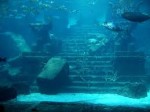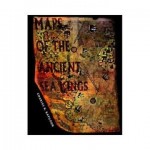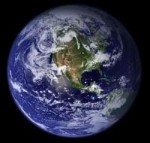Uniformitarianism is a philosophy. Its adherents believe that natural processes and the rates at which they have been observed to occur on earth and in space are the keys to understanding what has happened in the past. They assume that such processes as erosion, deposition, fossilization, and other natural processes occur at overall predictable rates. They are convinced that there was never a worldwide flood in which these rates would have occurred much more rapidly than what we can observe today. Continue reading Uniformitarianism–A Game Changer!
Author: admin
World History After Noah–Part II
World History After Noah – Part II
Conditions for travel by both people and animals were affected by a one time Ice Age, which occurred after the Flood as the results of two unrepeatable conditions. (1) The oceans contained warm water because of widespread exposure to magma, volcanic eruptions, and recently released hot subterranean water. The warm waters easily evaporated and formed clouds, producing massive amounts of snow during the winter months and frequent rains during the summer months.
(2) The summer months were often cooler than usual, because large amounts of volcanic ash in the air from widespread volcanic eruptions blocked the sun’s rays. The cooler temperatures of summer only allowed a partial melting of each year’s winter snows, so ice packs began to build up on the land. The persistence of warm oceans and cool summer temperatures resulted in more and more ice accumulations outside the temperate regions.
World History After Noah
World History After Noah – Part I
The human survivors of the Flood emerged to find dry ground after more than a year of living in the Ark. There was no trace of the former pre-Flood civilizations. All that remained of most plants and animals were now found as trillions of fossils embedded in layers of rocks and as some new plant growth from germinating seeds, spores, and adventitious growths.
Wild animals and birds on the Ark were released to return to the natural environment and reproduce. Domesticated plants and animals were tended on farms.
The human survivors began to repopulate the world as children were born into large families. Within a few generations, there were several thousand people on the earth.
World History From Adam to Noah
Is there a logical timeline of world history that fits into a roughly 6000 year span rather than millions and millions of years as taught in most history books? We think so. . .
In the beginning, the world, all living things, and humans were purposefully designed and created by God, along with everything needed to sustain life and the universe. This was approximately 4000 years before the time of Jesus’ earthy ministry.
The first man and woman, Adam and Eve, appeared on earth fully formed and mature. They did not gradually evolve from ape-like animals. Nor did they need millions of years to learn a language or how to make and use tools. All of this was built-in knowledge, somewhat like a computer with built-in programs. Continue reading World History From Adam to Noah
New Emphasis on Darwinian Evolution
I wrote the following article as a Guest Opinion in the May 25, 2014 issue of The Baptist Record. It is vitally important to consider how 13 years of being progressively taught about the evolutionary version of origins will affect the worldview and religious beliefs of our young people Continue reading New Emphasis on Darwinian Evolution
Remains of Cities Built on the Continental Shelf
Remains of Cities Built on the Continental Shelf

Some of the world’s greatest mysteries are remains of cities, temples, and other man made structures all over the world on the earth’s continental shelves below the surface of the oceans. A few are found in sites only tens of feet below the ocean surface. Others are found in places a few hundred feet deep.
The remains have been subjected to ocean currents, as well as chemical and physical erosion for thousands of years. Part of the mystery is why there are any remains of man made structures at all. Continue reading Remains of Cities Built on the Continental Shelf
Lessons from Jehoshaphat for 2014

As events in 2014 become more dismaying for Christians, I find myself relating to an ancient group of people from the kingdom of Judah. Three powerful nations made an alliance with each other to invade and conquer Judah by force. Their armies were already marching toward the capitol city of Jerusalem when word came of the impending invasion. The people of Judah knew they would be no match against their enemies in a military battle.
The True Source of Ancient World Maps

The True Source of Ancient World Maps
Maps of places all over the world began appearing as early as the 1300s. The maps included portions of North and South America, Central America, Antarctica, and Asia. Historians familiar with the maps have suggested luck, an unsolved mystery, and even space aliens as the sources for them. However, there is a logical explanation that begins with an account of history recorded in the Bible. There is every indication that a worldwide flood actually occurred about 4000 years ago, destroying the entire population of the earth except for Noah and his family.
What Do Ancient World Maps Tell Us?
What Do Ancient World Maps Tell Us?

Published By: Souvenir Press
London
“In 1492, Columbus sailed the ocean blue.” This was a little jingle my teacher taught the class when we were studying American history to help us remember an important date. We were told that this was the year when seaworthy ships first began to cross the Atlantic Ocean and explore new worlds. It was assumed that accurate surveying and mapping methods were not used by earlier civilizations. Another assumption found in most history texts is that the earliest humans were ape-like cavemen who gradually, over hundreds of thousands of years, learned to talk, develop tools, build houses and ships, and become civilized.
In 1492, some of the known regions of Europe and Northern Africa were not well surveyed, and maps of these areas were often inaccurate. When accurate maps of yet undiscovered parts of the world began to show up, these assumptions were challenged. So, how did Turkish admirals and other come to possess maps of places all over the world that were drawn during the 1300s AD through the 1500s AD and later? Continue reading What Do Ancient World Maps Tell Us?
The Questionable Teaching About Climate Change
 In 2013 in the summer month of December (for the Southern Hemisphere), an Australian climate-change professor led a group of scientists and tourists to retrace a 1912 research expedition in Antarctica. One of goals of the trip was to gauge how a warming climate has affected the continent. However, two weeks into the trip their ship was firmly trapped in ice. Two more ice breaker vessels were sent to rescue the ship, and one of them also became trapped in the ice. Unable to break the thick layers of ice, the passengers were finally rescued by a helicopter, leaving only the crew to remain and hope the ice would soon melt enough to break free.
In 2013 in the summer month of December (for the Southern Hemisphere), an Australian climate-change professor led a group of scientists and tourists to retrace a 1912 research expedition in Antarctica. One of goals of the trip was to gauge how a warming climate has affected the continent. However, two weeks into the trip their ship was firmly trapped in ice. Two more ice breaker vessels were sent to rescue the ship, and one of them also became trapped in the ice. Unable to break the thick layers of ice, the passengers were finally rescued by a helicopter, leaving only the crew to remain and hope the ice would soon melt enough to break free.
Meanwhile in the United States, record cold temperatures covered more than half of the country. For the past twelve years, average world temperatures have remained unchanged. There has been a vastly smaller warming trend than what was predicted by the U.N.’s Intergovernmental Panel on Climate Change (IPCC) about 24 years ago. Since the late 1800s, the rise in average global temperatures has been a little over one-half degree Celsius.
So, have the world’s climate researchers had second thoughts about a global warming trend? Well, yes and no.
There are basically two groups of climate researchers and they have come to very different conclusions, even as they study the same data. Both groups acknowledge that CO2 and other greenhouse gases have the potential to warm the earth’s average temperature. Both groups acknowledge that there is an increase in the amount of CO2 and other greenhouse gases that are going into the atmosphere.
However, one group staunchly believes that as a result of an increase in greenhouse gases, the temperature of thee earth will continue to warm, the polar ice caps will begin to melt, sea levels will rise, coastal cities will flood, and eventually the world’s health and economic structures will be significantly disrupted. This group even found a way to blame the colder than normal temperatures of December and January on disruptions caused by warming temperatures.
The other group finds the threat of global warming to be greatly exaggerated. They have concluded that the slight increase in average global temperatures will be absorbed by the earth’s natural systems with minimal and non-catastrophic effects on the earth. They consider that earthquakes, volcanoes, and other natural events play a role in climate changes.
The first group believes that the cause of the warming trend is anthropogenic or human-induced. The solution, they believe, will be found in international treaties, stricter laws and regulations, and carbon exchanges. The Kyoto Treaty from several years ago was an attempt to get the world’s nations to agree to a series of dramatic restrictions on industries and sources of energy. One of the problems with Kyoto is that all nations are not willing to accept the restrictions. China, in particular, has greatly increased greenhouse gas emissions during the past five years. Even if the U.S. agreed to the restrictions, China and other nations would offset our efforts.
It would seem that the two groups of scientists would find a way to resolve conflicts regarding how they interpret the evidence in a professional manner. For decades, scientists have submitted their research to open debates and professional critiques from other scientists in order to filter out weak explanations and reinforce the more valid ones.
However, when it comes to certain environmental issues, there is a decidedly non-professional aspect. Instead of just presenting scientific research that is subject to open debate and critical reviews, there is often an attempt to malign competing researchers. Competitors are often accused of lying, falsifying data, and participating in other unprofessional actions. One large publication blames Fox News and talk radio with inciting “climate change deniers” with emotionally charged arguments. A number of publications refuse to print articles written by those they call “climate change deniers.” Large federal research grants, pressure from certain groups of scientists, and support from certain politicians seem to be more of an incentive than an honest search for what is really true.
I am referring to this situation because there is a new push in education to convince young children of the dangers of climate change, so they will be prepared to take decisive action on environmental issues as adults. The proposed Next Generation Science Standards are designed to fit with the math and language Common Core standards.
This program approaches climate change and environmental issues, as well as evolution, from the position that debate and challenging scientific evidence are not necessary. The claim is made that all reputable scientists agree that evolution is true and that climate change is a major problem that needs to be addressed in order to prevent catastrophic events in the future.
There is a decided shift in the new science standards to include more information about both evolution and environmental issues. In the life science category, evolution and the environment make up about 50% of the standards. Both topics will be taught without scientific challenges. Furthermore, these topics will begin in the earliest grades and continue in a progressive way through high school.
I expect that if children are taught from K-12 that humans are causing great damage to the earth with factories and machines and burning fuels, they will be ready as young adults to accept international treaties and laws that will restrict many of our freedoms. This is especially true for the youngest students. After all, many children believe in Santa Clause, the tooth fairy, and the Easter bunny, so believing whatever their teacher tells them is not a great stretch.
Parents, teachers, and school officials have a huge responsibility to be diligent and informed about what children are being taught. Taking care of the environment has been, and continues to be, a very important topic for students to learn. Recycling, maintaining clean water supplies, keeping the air free from pollutants, and protecting our food supplies are a few of the environmental issues about which students need to stay informed.
My warning is directed toward controversial scientific topics where no debate is allowed, claiming that all reputable scientists agree that one side is true. Since Next Generation Science Standards have yet to be adopted in most states, parents, teachers, school officials, as well as elected legislators need to take sufficient time to adopt a balanced science curriculum that doesn’t promote an agenda.